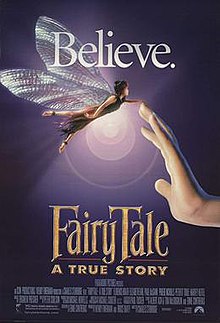FairyTale: A True Story
| FairyTale: A True Story | |
|---|---|
 Theatrical release poster | |
| Directed by | Charles Sturridge |
| Screenplay by | Ernie Contreras |
| Story by | Albert Ash Tom McLoughlin Ernie Contreras |
| Produced by | Bruce Davey Wendy Finerman |
| Starring |
|
| Cinematography | Michael Coulter |
| Edited by | Peter Coulson |
| Music by | Zbigniew Preisner |
Production companies | Icon Productions Icon Entertainment International Wendy Finerman Productions Anna K. Production C.V.[1] |
| Distributed by | Paramount Pictures (United States) Icon Entertainment International (Internationally) |
Release date | 24 October 1997 (United States) |
Running time | 99 minutes |
| Countries | United States France |
| Language | English |
| Box office | $18 million |
FairyTale: A True Story is a 1997 fantasy drama film directed by Charles Sturridge and produced by Bruce Davey and Wendy Finerman. It is loosely based on the story of the Cottingley Fairies, and follows two children in 1917 England who take a photograph soon believed to be the first scientific evidence of the existence of fairies. The film was produced by Icon Productions.
Plot
Early 20th-century Europe was a time and a place rife with conflicting forces, from the battlefields of
Polly Wright, Elsie's mother, is deep in mourning for her son Joseph, a gifted artist who died at the age of ten, and she keeps Joseph's room and art works intact. Elsie is not allowed to wear colours or to play with his toys, but she has taken the unfinished fairy-house he built up to her garret bedroom where her doting father, Arthur, regales her with
No one except Houdini believes that young children could be capable of photographic fraud, and Conan Doyle himself arrives at the girls' home with Houdini, Gardner and two new cameras. Arthur catches Houdini poking around and tells him point-blank that he doesn't believe that the fairies are real, but that no trickery took place in his darkroom either. Abetted by the buffoonish Gardner, Elsie and Frances soon come up with two more photos and Conan Doyle has the story published in The Strand Magazine, promising everyone's names will be changed. But a newsman soon identifies the beck in Cottingley, tracing the girls through the local school and besieging the family. Hundreds of people invade the village in automobiles and on foot, and the fairies flee the obstreperous mobs. By way of apology to the fairies, the girls finish Joseph's fairy-house and leave it in the forest as a gift.
The girls are invited to London by Conan Doyle, where they embrace their celebrity and see Houdini perform. In a quiet moment backstage Houdini asks Elsie if she wants to know how he does his tricks, and she wisely declines. And when a reporter asks, he exclaims, "Masters of illusion never reveal their secrets!" Back in Yorkshire, while the girls and Polly are away, Arthur has a chess match with a local champion reputed to be mute, and the newsman breaks into their house. He discovers a cache of paper dolls in the form of fairies in a portfolio in Joseph's room, but he is frightened away by the apparition of a young boy, leaving the evidence behind. Arthur wins his match, wringing a shout from his opponent, and another myth is debunked. After the children return home, the fairies reappear, and finally, Frances' father comes home as well.
Cast
- Peter O'Toole as Sir Arthur Conan Doyle
- Elsie Wright
- Elizabeth Earl as Frances Griffiths
- Harvey Keitel as Harry Houdini
- Paul McGann as Arthur Wright
- Bill Nighy as Edward Gardner
- Phoebe Nicholls as Polly Wright
- Anna Chancellor as Peter Pan
- Mel Gibson as Sergeant Major Griffiths
- Don Henderson as Sydney Chalker
Background
In 1920 Sir
Filming and production
Much of the film was shot on location in Cottingley,
Release
The film was released in the United States on 24 October 1997. Paramount Pictures distributed the film in the United States while international sales were handled by Icon Entertainment International. Warner Bros. distributed the film in the United Kingdom.[5][6]
The film got its UK premiere in
Reception
FairyTale: A True Story received mixed reviews from critics, as it holds a rating of 56% on Rotten Tomatoes from 32 reviews, with an average rating of 6.1/10. The consensus states: "Believe -- Fairy Tale: A True Story's sense of wonder and magic may help overlook the science behind the film's flaws."[7] Audiences polled by CinemaScore gave the film an average grade of "B+" on an A+ to F scale.[8]
The film grossed just over $14 million in the US and Canada.[9] In the UK, the film grossed £2.4 million ($4 million)[10] for a worldwide total of over $18 million.
See also
- Cottingley Fairies
- Photographing Fairies, another 1997 film also inspired by the Cottingley Fairies.
- The Cottingley Secret, a 2017 novel by Hazel Gaynor
- The Cottingley Cuckoo, a 2021 novel by Alison Littlewood
References
- ^ "Fairytale A True Story (1997)". Bfi.org.uk. Archived from the original on 10 March 2017. Retrieved 31 October 2017.
- ISBN 978-0-8032-6655-1
- ^ a b c d e "A Premiere Performance". Bradford Telegraph and Argus. 9 February 1998. Retrieved 4 April 2021.
- ^ a b "Fairy Tale: A True Story". Bradford Film Heritage. Retrieved 4 April 2021.
- ^ "Fairy Tale: A True Story (1997) - Overview - TCM.com". Turner Classic Movies. Retrieved 31 October 2017.
- ^ "FAIRYTALE: A TRUE STORY - Filmbankmedia". Filmbankmedia.com. Retrieved 31 October 2017.
- ^ "Fairy Tale: A True Story (1997)". Rotten Tomatoes. Retrieved 10 January 2023.
- ^ "Home". CinemaScore. Retrieved 20 December 2022.
- ^ "Fairy Tale: A True Story (1997) - Box Office Mojo". Boxofficemojo.com. Retrieved 31 October 2017.
- ^ "British biz at the box office". Variety. 14 December 1998. p. 72.
